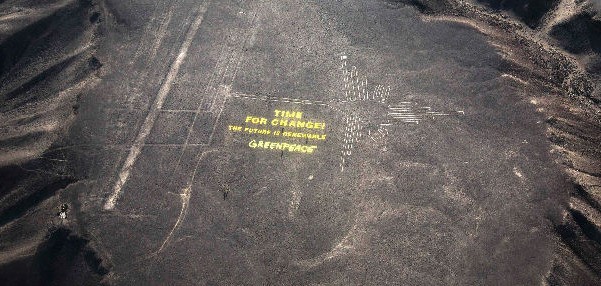VICTORIA – In case you missed the outcome of the latest United Nations climate change conference in Lima, Peru, it was another costly, embarrassing failure.
This one is likely to be remembered mostly for a staggeringly stupid stunt by Greenpeace employees, who were threatened with prosecution for defacing the Nazca Lines, a world heritage site in the Peruvian desert.

These vast 1,500-year-old petroglyphs, visible from space, are among the great mysteries of archaeology. “Time for change!” blared huge yellow letters dragged across the sacred site by paid protesters trampling the delicate terrain. I’ll say it’s time for a change, starting with scratching Greenpeace off your Christmas card list.
Earlier there was the spectacle of Canada’s national media, reflexively denouncing Ottawa’s supposed inaction on greenhouse gases after U.S. President Barack Obama unveiled a surprise climate agreement with China in advance of Peru.
“Over to you, Mr. Prime Minister,” chirped CBC anchor Wendy Mesley, joining other TV networks in falsely portraying the U.S. deal as a breakthrough.
This non-binding gesture soon produced many cartoons, one of which shows Obama stripped to his underwear in a poker game with Chinese President Xi Jinping, who is surrounded by a pile of chips and an American flag.
The U.S.-China announcement served as a preview of Peru, where developing countries would again refuse any substantive restrictions on their fuel use. China graciously agreed to continue ramping up its world-leading greenhouse gas emissions until 2030, while lame-duck Obama pretended he could commit the U.S. to further reductions.
Between them, the U.S. and China account for about half of global human-caused carbon emissions. Due mostly to the surge from China and India, Canada’s share has fallen from two per cent to 1.5, which should help put all those “tar sands” protests into perspective.
Days later, Environment Canada released its latest national emission statistics, an event ignored by most media.
“Between 2005 and 2012, total Canadian GHG emissions decreased by 5.1 per cent, while the economy grew by 10.6 per cent over the same period,” the report states.
B.C. Environment Minister Mary Polak joined the throngs who jetted to Lima. There she met officials from California and other U.S. states to re-announce their modest efforts to put a price on carbon emissions. TV anchors and other wide-eyed innocents might have been left with the mistaken impression that the huge U.S. petroleum industry is cutting back, when in fact it has grown enormously thanks to shale oil and gas production.
And California continues to produce, by its own state government measure, the most carbon-intensive heavy crude in North America.
Overshadowing all of this is the drop in the world price of oil, mainly the result of Saudi Arabia flooding the market in an effort to push competitors out of business. In the latest sign of the U.S. public’s lack of interest in reducing emissions, sales of larger vehicles immediately spiked up as gasoline prices fell.
I’m still receiving criticism for a recent column in which I declared myself an “agnostic” on human-caused global warming. Agnostic means searcher, and my search has continued for real signs of climate change and its potential causes.
Our glaciers are receding, no question, but the current trend started around the 1850s, when a sport utility vehicle had one horsepower in leather harness and B.C. was about to be declared a British colony.
But amid the noise, there is serious evidence being put forward that our province is undergoing a climate shift with major consequences. And there are calls for action.
I’ll discuss that next week.
Tom Fletcher is legislature reporter and columnist for Black Press.Email: tfletcher@blackpress.ca Twitter: @tomfletcherbc
